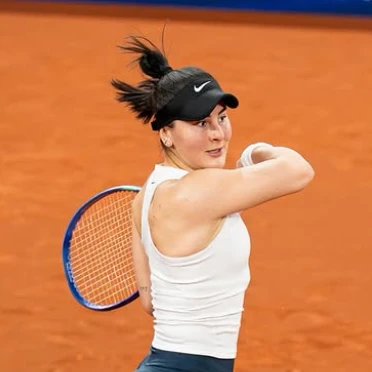“There’s a big difference between match point and losing a match.” Those words were spoken by former world No. 7 Peter McNamara of Australia after he defeated American Harold Solomon, a former No. 5, in the second round of the 1982 French Open.
They were timely because McNamara had just saved a match point and rallied to beat Solomon, the 1976 Roland Garros finalist, 2-6, 3-6, 7-6, 6-1, 6-3.
Every tennis match – retirements and defaults excepted – arrives at match point at least once. They can sometimes be boring in one-sided contests because of their inevitability, or fraught with thrills because they could just be a prelude to even more exciting moments to come.
For that instant, the fate of the players hangs on every strike of the ball – with one bold, or faint-hearted, racquet swing deciding the outcome after hours of hard-fought competition.
With the ATP season in its final stages, here’s a look at how match points have been cruel and kind to players in 2015.
The master of saving match points so far has been Jeremy Chardy (above), and he did it at Rogers Cup in Montreal in August. Chardy, ranked No. 49, survived a grand total of seven in overcoming No. 12 John Isner 6-7(9), 7-6(13), 7-6(4) in the quarter-finals. The Frenchman, 28, saved five in the madcap 15-13 second-set tiebreak and then two more when he served at 5-6 in the final set.
“It was an incredible match, full of emotions,” Chardy said afterward about the three-hour, rain-interrupted affair. “These kind of matches are very tough because you have to stay really focused. Every small chance, you have to take it.”
Chardy’s chance came in the ultimate tiebreak when Isner missed a backhand long serving at 3-4.
[caption id="attachment_38458" align="alignnone" width="600"] Photo: Arturo Velasquez/Tennis Canada[/caption]
Photo: Arturo Velasquez/Tennis Canada[/caption]
About being on the precipice of elimination so many times, Chardy explained, “if you start to think about the match points, the break points, you start to get nervous. That’s the way to miss the shot.
“I was not thinking about the match points. I was just thinking about my serve and what I want to do with it. That’s it.”
Chardy saving the seven match points wasn’t his only dance with destiny in Montreal – he saved two match points against Leonardo Mayer in a 4-6, 7-6(4), 6-2 second-round win. Mayer, memorably, failed to convert five match points against Roger Federer in the second round in Shanghai a year ago.
Mayer also lost to Denis Istomin in Nottingham on grass in June this year after having a match point. But it wasn’t all match-point deception for the 28-year-old Argentine – in Sydney in January he saved one in a 4-6, 6-1, 7-6(3) victory over Jerzy Janowicz.
In second place behind Chardy in terms of multiple match points saved are Janowicz and Martin Klizan, both with six.
Janowicz saved his in a 2-6, 7-6(1), 7-5 win over Dustin Brown in Montpellier in February, while Klizan came back from the brink six times in the Brisbane second round in January, advancing 1-6, 7-6(6), 7-6(7) over Alexandr Dolgopolov.
Feliciano Lopez, 34, is the champion of the most comebacks from the edge-of-the-ledge in matches so far in 2015. He did it three times, twice during the Australian Open. At Melbourne Park he beat Denis Kudla in the first round (one MP) and Adrian Mannarino in the second round (two MPs) before saving one in a 6-2, 5-7, 7-6(5) victory on clay over Marsel Ilhan in Barcelona in April.
But the stylish lefthander from Madrid also experienced the losing end once – failing to capitalize on two match points against Robin Haase on clay in Estoril in April. The final score was 4-6, 7-6(2), 6-4 for the Dutchman.

There were several players who salvaged two matches after facing match point or points – including Milos Raonic. The current world No. 9 saved three in a memorable 4-6, 7-6(10), 7-5 quarter-final upset of Rafael Nadal in Indian Wells and then just last week one match point in beating Roberto Bautista Agut 6-4, 6-7(3), 7-6(5) in Shanghai.
Among the other players besides Raonic and Chardy winning after saving match point (or points) two times in 2015 have been Marin Cilic, Grigor Dimitrov, Haase, Thanasi Kokkinakis, Rajeev Ram (both on his way to winning the title in Newport, R.I.), Joao Sousa, Janko Tipsarevic and Fernando Verdasco.
The most snake-bit loser after holding match point has been Bautista Agut. The 27-year-old Spaniard has lost four times in 2015 with victory just a point away. Besides Raonic last week, there was Aljaz Bedene in Chennai (4 MPs), Richard Gasquet in Dubai (1 MP) and Verdasco at Queen’s Club (3 MPs). Bautista-Agut, ranked No. 23, did have fortune fall his way once when he saved three match points while defeating Teymuraz Gasbashvili 6-3, 5-7, 7-5 in St. Petersburg last month.
Just to put Bautista Agut’s four ‘match point’ losses in perspective – it also happened four times in one season (2010) to none less than the great Federer:
- lost to Marcos Baghdatis (3 MPs) – Indian Wells
- lost to Tomas Berdych (1 MP) – Miami
- lost to Novak Djokovic (2 MPs) – US Open
- lost to Gael Monfils (5 MPs) – Paris-Bercy
Federer also lost once this year after holding match points – in the second round in Madrid on clay against Nick Kyrgios when he failed to finish off two of them. The bold 20-year-old Aussie won a cracker contest 6-7(2), 7-6(5), 7-6(12).
Among other players tasting defeat after having match point, Bernard Tomic places second behind Bautista Agut with three losses – Berdych in Miami (4 MPs), Tipsarevic in Munich (1 MP) and Kokkinakis at Roland Garros (3 MPs).
Included in those players losing twice after failing to convert a match point (or points) were Mayer, Ivo Karlovic, Dimitrov, Mannarino, Lleyton Hewitt, Isner, Brown, Gabashvili, Ernests Gulbis, Alejandro Gonzalez and Jiri Vesely.
Vasek Pospisil experienced match-point frustration once in 2015 – losing 5-7, 6-4, 7-6(9) to Dominic Thiem in the first round in Munich in April.
[caption id="attachment_38456" align="alignnone" width="1024"] Photo: Arturo Velazquez/Tennis Canada[/caption]
Photo: Arturo Velazquez/Tennis Canada[/caption]
Among the so-called Big Four, only Federer and Nadal have lost after holding match point in 2015. Andy Murray has had a match point ‘neutral’ year so far while world No. 1 Novak Djokovic is the only one to have survived after facing match point. He saved two in a memorable 5-7, 7-6(7), 6-1 quarter-final victory over Gulbis at that eventful Rogers Cup in Montreal in August. The vicissitudinous Latvian led 6-4 in the second-set tiebreak but visibly tightened, particularly on one forehand unforced error.
Djokovic, who saved two match points for the first time since beating Andy Murray in Shanghai in 2012, wrote “very lucky” on the TV camera lens after the match.
He also had a little fun with the crowd afterward – “inflating” his bicep with a pretend thumb pump as he changed shirts courtside.
Historically, four of the most famous instances of multiple match points saved include:
- 1. The nine saved by Nick Kyrgios at Wimbledon in 2014 in a 2-6, 6-7(4), 6-4, 7-5, 10-8 win over Richard Gasquet.
- The nine saved by Vince Spadea in a 7-5, 1-6, 4-6, 7-6(7), 9-7 victory over Florent Serra at Roland Garros in 2004.
- The seven saved by 41-year-old Pancho Gonzales in his classic 22-24, 1-6, 16-14, 6-3, 11-9 Wimbledon win over fellow-American Charlie Pasarell in 1969.
- The 10 saved by charismatic Adriano Panatta of Italy in his opening round win over Kim Warwick of Australia on his way to the Italian Open title in 1976. Amazingly in the first round of his very next tournament – the French Open – Panatta saved a single match point with a desperation lunging volley against little-known Czech Pavel Hutka and eventually wound up winning the only Grand Slam championship of his career.

How to describe Panatta (above with cigarette, wife Rosario and the late Vitas Gerulaitis)? He was Fabio Fognini but bigger, more artful and with superior matinee idol looks. But both shared a common trait – a predisposition to be unpredictable and to have a taste for the good life.
Frankie D in Las V

Frank Dancevic is playing the Challenger event in Las Vegas this week. Unfortunately, he lost his first-round match 6-4, 6-2 on Monday to No. 101-ranked Tim Smyczek of the U.S.
On Sunday evening (above), he was practicing with Giovanni Lapentti at the Frank and Vikki Fertitta Tennis Complex on the campus of the University of Nevada Las Vegas.
The sky, as is visible in the photo on top here, was darkly ominous but the two managed to get in a full session.

Dancevic, 31, and Lapentti, 32, won the 2001 Wimbledon junior boys doubles title together. They have remained friends and Dancevic said they go back as far as playing as juniors when they were 12 years old.
Lapentti is, of course, the brother of former world No. 6 (1999) Nicolas Lapentti. Now aged 39, Nicolas, an ex-president of the Ecuadorian tennis federation, is currently involved in promoting the expansion of HD television in his homeland.
The life of a tennis player is a lot about travel, and last week the No. 188-ranked Dancevic and his wife Nikolina got their journey by car from California to Las Vegas interrupted by a mudslide that forced a three-hour detour. Leaving last Thursday morning, they didn’t arrive in Las Vegas until 1 a.m. on Friday.
Next January, Dancevic will be trekking Down Under for the Australian Open qualifying event. At the end of the Aussie Open he will head for New Zealand where his 28-year-old sister Monika, a fine tennis player in her own right at the University of Georgia, will be getting married to a Kiwi.
Genie exercising... her right to vote
https://twitter.com/geniebouchard/status/656253529074462720 No word on whom Genie Bouchard was voting for on Monday in the Canadian federal election – but she was looking quite sophisticated in doing so.To be eligible to vote, Canadians must be 18 years of age on election day. So, since Bouchard would only have been 17 at the time of the last federal election on May 2, 2011, this would be her first time casting a ballot in a federal election.
Feature photo: Arturo Velasquez/Tennis Canada






